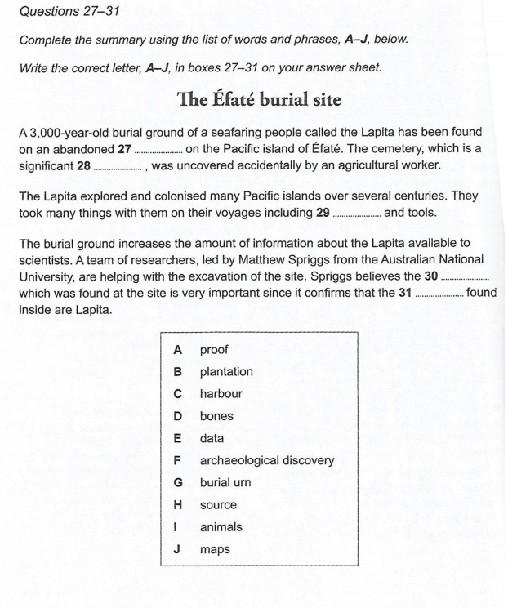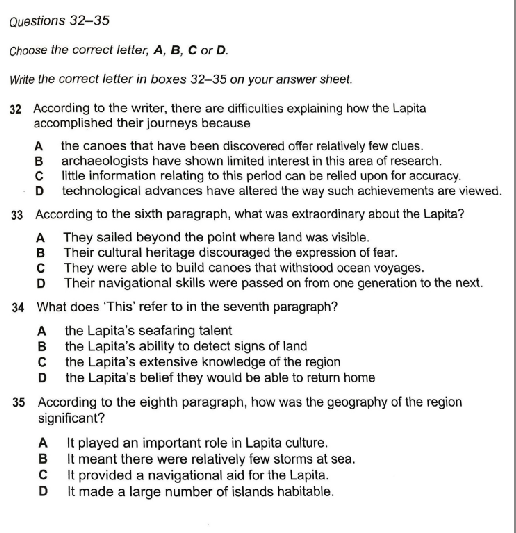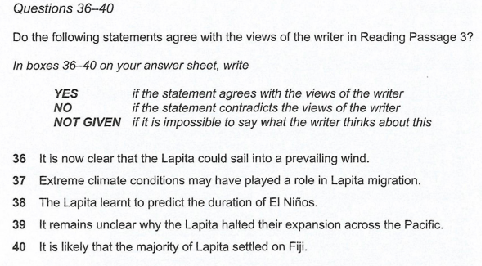剑桥雅思10阅读:Test3雅思阅读PASSAGE3真题+答案+解析
发布时间:2021-03-17 关键词:剑桥雅思Passage3
Beyond The Blue Horizon
蓝色海平线外
Ancient Voyagers Who Settled the Far-Flung Islands of the Pacific Ocean
居住在太平洋遥远岛屿上的古代航行者
An important archaeological discovery on the island of Efate in the Pacific archipelago of Vanuatu has revealed traces of an ancient seafaring people, the distant ancestors of today’s Polynesians. The site came to light only by chance. An agricultural worker, digging in the grounds of a derelict plantation, scraped open a grave—the first of dozens in a burial ground some 3,000 years old.It is the oldest cemetery ever found in the Pacific islands, and it harbors the remains of an ancient people archaeologists call the Lapita.
一项关于太平洋 Vanuatu 群岛上的岛的重要考古发现,揭开了一个古老的航海种族的行踪,该种族恰恰也是今天Polynesians 亚种族的远古祖先。Efate 岛是偶然被世人发现的。一位农业工作者,在挖掘一个被废弃的种植园时,挖开了一个坟墓,而该坟墓仅是一块大约有 3000 年历史的墓地上数十个坟墓中的个。 这是在太平洋群岛上至今为止发现的最古老的墓地,它里面躺着一个远古种族的遗体。考古学家们称该种族为Lapita。
They were daring blue-water adventurers who used basic canoes to rove across the ocean. But they were not just explorers. They were also pioneers who carried with them everything they would need to build new lives—theirlivestock, taro seedlings and stone tools. Within the span of several centuries, the Lapita stretched the boundaries of their world from the jungle-dad volcanoes of Papua New Guinea co the loneliest coral outliers of Tonga.
Lapita 种族是勇敢的蓝色大海上的冒险者,他们曾经用简单的独木舟穿越海洋。但是他们不仅仅是探险者。他们也是开拓者,携带了一切需要的物品来创建新生活,这些物品包括他们的家畜,芋头幼苗和石具。在长达几个世纪的时间里,种族把他们世界的边界,从Papua New Guinea 岛上覆盖着丛林的火山群,延伸到汤加群岛上最孤寂的布满珊瑚的外围地带。
The Lapita left precious few dues about themselves, but Efate expands the volume of data available to researchersdramatically. The remains of 62 individuals have been uncovered so far, and archaeologists were also thrilled to find six complete Lapita pots. Other items included a Lapita burial urn with modeled birds arranged on the rim as though peering down at the human remains sealed inside.‘It’s an important discovery’, says Matthew Spriggs, professor of archaeology at the Australian National University and head of the international team digging up the site, Tor it conclusively identifies the remains as Lapita.’
Lipita 种族仅仅留下可几条关于自身的宝贵线索,但是Efate 岛大大地扩充了对研究象来说有用数据量。62 位Lapita 人的遗体至今经被挖掘出来了,考古学家们同时也激动地发现了六个完整的陶罐。其他发掘出的物品包括一个Lipita 人的骨灰瓮,瓮的边缘散布着仿制的小鸟,仿佛在向下凝视着密封在里面的 Lapita 的遗体。“这是个重要的发现,”澳大利亚国立大学考古学兼挖掘场地的国际团队的总负责人Matthew Spriggs 表成“因为它令人信服地确定了遗体便是Lapita 种族。”
DNA teased from these human remains may help answer one of the most puzzling questions in Pacificanthropology: did all Pacific islanders spring from one source or many? Was there only one outward migrationfrom a single point in Asia, or several from different points?‘This represents the best opportunity we’ve had yet,’ says Spriggs, ‘to find out who the Lapita actually were, where they came from, and who their closest descendants are today.’
从这些人类遗体中提取出来的DNA 可能能够帮助解答其中一个在太平洋人类学中最让人困惑的问题,即所有的太平洋岛上居民来源于一个祖先还是多个。是只有一批来自亚洲某个地方的外来移民, 还是有若千批来自不同地方的外来移民? “Efate 岛的发现是我们有史以来的机会,”Sprigg 说道,“来探索 Lapita 种族到底是怎么样的种族,他们来自哪里,以及当今与他们关系最紧密的后代是哪些种族。”
There is one stubborn question for which archaeologyhas yet to provide any answers: how did the Lapita accomplish the ancient equivalent of a moon landing, many times over? No-one has found one of their canoes or any rigging, which could reveal how the canoes were sailed. Nor do the oral histories and traditions of later Polynesians offer any insights, for they turn into myths long before they reach as far back in time as the Lapita.
这里还有一个棘手的问题,考古学至今提供不了多少答案,即Lapita 人是怎么样在远古时期完成相当于月球登陆般艰难的穿越海洋的行动,而且还那么? 至今没有人发现一艘他们的独木舟或任何绳索,以此来发现他们的独木舟是如何航行的。同时在后来的 Polynesians 人的口头相传的历史故事和传统中也没能提供什么相关线索,因为在这些故事传统流传到 Lapita 那个时期以前,就已经变成神话传说了。
‘All we can say for certain is that the Lapita had canoes that were capable of ocean voyages, and they had the ability to sail them,’ says Geoff Irwin, a professor ofarchaeology at the University of Auckland. Those sailing skills, he says, were developed and passed down over thousands of years by earlier mariners who worked their way through the archipelagoes of the western Pacific, making short crossings to nearby islands. The real adventure didn’t begin, however, until their Lapita descendants sailed out of sight of land, with empty horizons on every side. This must have been as difficult for them as landing on the moon is for us today. Certainly it distinguished them from their ancestors, but what gave them the courage to launch out on such risky voyages?
“我们可以确定的是Lapita 人那时候已经有能够开展海洋航行的独木舟了,并且他们有能力行驶独木舟。”奥克兰大学的考古学Geoff Irwin 表示。他说道,那些航行技能被早期航海人员发展并流传了数千年,这些早期的航海人员靠自己想方设法穿越了西部太平洋的群岛,开辟了通向邻近岛屿的短路线。然而,真正的冒险还没开始,直到他们的后裔行驶出大陆的视线范围,大陆变得每个方向都没有界限。而这肯定对他们来说很困难,如同当今我们登陆月球一样。当然这样的穿越举动使得他们从他们的祖先中突显出来,但是是什么给了他们勇气发起如此危险的航行之旅呢?
The Lapita’s thrust into the Pacific was eastward, against the prevailing trade winds, Irwin notes. Those naggingheadwinds, he argues, may have been the key to their success. ‘They could sail out for days into the unknown and assess the area, secure in the knowledge that if they didn’t find anything, they could turn about and catch a swift ride back on the trade winds. This is what would have made the whole thing work.’ Once out there, skilled seafarers would have detected abundant leads to follow to land: seabirds, coconuts and twigs carried out to sea by the tides, and the afternoon pile-up of clouds on the horizon which often indicates an island in the distance.
Irwin 指出,Lapita 人进入太平洋的航向是向东的,这不同于通常的顺风。他同时表明,这样艰难的逆风航行方式,也许正是也们成功的关键。“他们能够行驶数天进入未知‘和可以到达的’地带,因为他们确定地知道如果一无所获,他们能够转向乘着顺风返这正是促成整个探索行动成功的关键。”一旦出行,有经验的海员能够观测并跟随大量的指引线索到达新大陆,比如海鸟,被潮汐入大海的椰子和细枝,和下午海平线上堆积的云层,这些云层通常代表不远处有海岛。
For returning explorers successful or not, the geography of their own archipelagoes would have provided a safety net.Without this to go by, overshooting their home pores, getting lost and sailing off into eternity would have been all too easy. Vanuatu, for example, stretches more than 500 miles in a northwest-southeast trend, its scores of intervisible islands forming a backstop for mariners riding the trade winds home.
对于返航的探险者,不论成功与否,他们自己群岛的地形就已经提供了一个安全的网罩。如果在途中没有这个安全的网罩,航行偏离他们自己的港口,迷失甚至是行驶向死亡之路将变得很容易发生。比如,Vanuatu 岛,在西北到东南方向上长度达 500 多英里,它相互可见的岛屿,为乘着顺风返航的航海员们形成增援,保护着他们。
All this presupposes one essential detail, says Atholl Anderson, professor of prehistory at the Australian National University: the Lapita had mastered the advanced art of sailing against the wind. 'And there's no proof they could do any such thing,' Anderson says. ‘There has been this assumption they did, and people have built canoes to re-create those early voyages based on that assumption.But nobody has any idea what their canoes looked like or how they were rigged.'
所有这些预设了一个重要的细节点,澳大利亚国立大学的史前时期研究 Atholl Anderson 说道,Lapita 人已经早早地掌握了先进的逆风航行的技能。“并没有证据证明他们能够做这样的事情,” Anderson 表示,“但这里已经假设他们能够这样做,同时基于这样的假设,人们已经制作独木舟来再次开展那些早期的航海探险。但是没有人知道他们的独木舟到底是怎么样的或者他们是怎么样装配索具。”
Rather than give all the credit to human skill, Anderson invokes the winds of chance. El Nino, the same climate disruption that affects the Pacific today, may have helped scatter the Lapita, Anderson suggests. He points out chat climate data obtained from slow-growing corals around thePacific indicate a series of unusually frequent El Ninos around the time of the Lapita expansion. By reversing the regular east-to-west flow of the trade winds for weeks at a time, these super El Ninos' might have taken the Lapita on long unplanned voyages.
与其全部归功于人类的技能,也得“考虑到自然风力产生的可能性”,Anderson 表示。厄尔尼诺现象,如今影响太平洋的这一异常气候,也许曾帮助分散 Lapita 人群的分布。他指出从太平洋周围生长缓慢的珊瑚中获取的气候数据暗示着大概在 Lapita 人对外扩张时期,存在一系列不平常且频繁的厄尔尼诺现象。通过反转一般东西流向的顺风且每次长达数周,这些超级厄年尼诺现象大概已经促使 Lapita 人开始漫长且未计划过的航行之旅。
However they did it, the Lapita spread themselves a third of the way across the Pacific, then called it quits for reasons known only to them. Ahead lay the vast emptiness of the central Pacific and perhaps they were too thinly stretched to venture farther. They probably never numbered more than a few thousand in total, and in their rapid migration eastward they encountered hundreds of islands - more than 300 in Fiji alone.
但是他们做到了,Lapita人分布在太平洋三分之一的岛屿上,之后由于若干只有他们知道的原因,停止了对外探索。前方太平洋中部有着大片仍未被开发的领域,也许他们太薄弱而无法继续往前探索扩张。可能总共人数算起来从未超过几千人,在他们向东的迁徙过程中,他们遇见了成百上千的岛屿,单单在斐济就有300多个岛屿。



Question 27
参考译文: 在太平洋 Efate 岛的一个废弃的____上,人们发现一个有着 3000 年历史的墓地, 里面躺着被称为 Lapita 人的海上居民。难度及答案:难度低;答案为 B
关键词: 3,000-year-old、 abandoned
定位原文: 第 1 段第 2 句“The site came... 3,000 years old.” Efate 岛是偶然被世人发现的。 一个农业工作者,在挖掘一个被废弃的种植园时,挖开了一个坟墓,而该坟墓仅是一块大约有 3000 年历史的墓地上数十个坟墓中的个。
解题思路: 由关键词“3,000-year-old”找到第 1 段第 2 句,又由于关键词 “abandoned” 相当于原文中的“derelict”故可得知答案为 B,即 plantation。
Question 28
参考译文: 该墓地是一个重要的_____,是在意外的情况下被一个农业工作者发现的。难度及答案:难度中等;答案为 F
关键词:significant、uncovered、 agricultural worker
定位原文:第 1 段第 1 句“An important archaeological discovery...Polynesians.” 一项关于太平洋 Vanuatu 群岛上的 Efate 岛的重要考古发现,揭开了一个古老的航海种族的行踪,该种族恰恰也是今天 Polynesians 种族的远古祖先。
解题思路: 由 agricultural worker 可以推出对应原文大概在第 1 段,又由于关键词“significant ” 和原文句的“important”是同义词,可得知答案应为 archaeological discovery,选 F。
Question 29
参考译文: 他们航行中携带了东西,包括___和工具。难度及答案: 难度低;答案为 I
关键词: and、tools
定位原文: 第 2 段第 2 句“They were also... stone tools.”他们也是开拓者,携带了一切需要的物品来创建新生活,这些物品包括他们的家畜,芋头幼苗和石具:
解题思路: 由关键词“tools”可以定位到第,2 段第 2 句,且由关键间“and” 得知,所填的 词与“tools”为并列关系。原文中的“livestock”相当于“animals”,故选择 I。
Question 30
参考译文: Spriggs 认为在场地里发规的非_____常重要,因为它证实了里面发现的_____是 Lapita 人。难度及答案: 难度中等;答案为 G
关键词:spriggs、important;
定位原文: 第 3 段第 3、4 句'“Other items included a... Lapita.”其他发掘出的物品包括一个 Lapita 人的骨灰瓮,瓮的边缘散布着仿制的小鸟,仿佛在向下凝视着密封在里面的 Lapita 人的遗体。‘这是个重要的发现,’澳大利亚国立大学考古学兼挖掘场的国际团队的总负责人 Matthew Spriggs 表示,‘因为它令人信服地确定了遗体便是 Lapita 种族。’
解题思路: 由词“Spriggs”可定位到第 3 段第 3、4 句,原文指出发现的骨灰瓮是一个重要的发现,由此可知,答案为 G,即 burial urn。
Question 31
参考译文: Spriggs 认为在场地里发现的_____重要,因为它证实了里面发现的_____是 Lapita 人。难度及答案: 难度中等;答案为 D
关键词:confirm, Lapita
定位原文: 第 3 段第 3、4 句 “Other items included a... Lapita.” 其他发掘出的物品包括一个 Lapita 人的骨灰瓮,瓮的边缘散布着仿制的小鸟,仿佛在向下凝视着密封在里面的 Lapita 人的遗体。‘这是个重要的发现,’澳大利亚国立大学考古学兼挖掘场地的国际团队的总负人 Matthew Spriggs 表示,‘因为它令人信服地确定了遗体便是 Lapita 种族。’
解题思路: 由词“Spriggs”可定位到第 3 段第 3、4 句,关键词“confirms”相当于原文中的"identifies”,而原文“confirms”后的“remains”相当于“bones”,故答案为 D。
Question 32
参考译文: 根据作者的文章,在解释 Lapita 人是如何完成航行的这一问题上有困难,其原因是什么?难度及答案: 难度中等;答案为 C
关键词: difficulties、accomplished their journeys
定位原文: 第五段整段,段意为:这里还有一个棘手的问题,考古学至今提供不了多少答案, 即 Lapita 人是怎样在远古时期完成相当于月球登陆般艰难的穿越海洋的行动,而且还那么? 至今没有人发现任何一艘他们的独木舟或绳索等装置,以此来发现他们的独未舟是如何航行的。同时后来的 Polynesians 人的口头相传的历史故事和传统中也没能提供什么相关线索,因为在这些故事传统流传到 Lapita 人那个时期的很久以前,就己经变成神话传说了。
解题思路: 由关键词“accomplished their journeys”,可定位到第 5 段。再由第 5 段知,至今没有人发现任何一艘他们的独木舟或绳索等装置,口头相传的历史故事和传统中也没能提供什么相关线索。故选择 C 。
Question 33
参考译文:根据第 6 段内容,Lapita 人最伟大的地方在哪里? 难度及答案: 难度中等;答案为 A
关键词:extraordinary、Lapita
定位原文: 第 6 段倒数第 2、3 句“…however, until... for us today.”然而,真正的冒险还没开始,直到他们的后代 Lapita 人行驶出大陆的视线范围,大陆变得每一个方向都没有界限。而这肯定对他们来说很困难如同,当今我们登陆月球一样。
解题思路: 第 6 段倒数第 2、3 句,可得知,Lapita 人真正的冒险是远行出大陆的视线范围, 这如同今天登陆月球一样难,笞案为 A 。
Question 34
参考译文:在第 7 段中“this”指代什么意思?难度及答案: 难度中等;答案为 D
关键词: this、the seventh paragraph
定位原文: 第 7 段第 3、4 句 “They could sail ...the whole work.” 他们能够行驶数天进入未知地带,因为他们确定地知道如果一无所获,他们能够转向乘着顺风返回。这正是促成整个探索行动成功的关键。
解题思路:由关键词“This”,“the seventh paragraph”可定位到第 7 段第 4 句。通读“This” 的上下文,可发现其指代的意思是 Lapita 人相信他们能够返回家的信念,故选择 D。
Question 35
参考译文:根据第 8 段内容,地区地势的重要性如何 ?难度及答案: 难度低;答案为 C
关键词: the eight paragraph, geography of region
定位原文:第 8 段首句“For returning explorers…a safety net.”对于返航的探险者,不论成功与否,他们自己群岛的地形就已经提供了一个安全的网罩。
解题思路: 由关键词 “the eight paragraph”,“geography of region” 可定位到第 8 段第 1 句, 原文中的“a safety net”相当于“a navigational aid”,故选择答案 C。
Question 36
参考译文: Lapita 人顺风而行,这一点现在很清楚。难度及答案: 难度中等;答案为 NO
关键词: prevailing wind
定位原文: 第 9 段整段,段意为:所有这些预设了一个重要的细节点,澳大利亚国立大学的史前时期研究 Atholl Anderson 说道:LaPita 人已经早早地掌握了先进的、逆风航行的技能。‘并没有证据证明他们能够做这样的事情,’ Anderson 表示,‘但这里已经假设他们能够这样做,同时基于这样的假设,人们已经制作独木舟来再次开展那些早期的海航探险。但是没有人知道他们的独木舟到底是怎么样的或者他们是怎么样装配索具等的。’
解题思路: 第 9 段指出,目前没有证据证明 Lapita 人能够掌握先进的逆风航行的技能。故该题答案为 No。
Question 37
参考译文: 极端的气候条件可能在 Lapita 人的迁徙上扮演重要角色。难度及答案: 难度低;答案为 YES
关键词: extreme climate conditions、migration
定位原文: 第 10 段第 2 句“El Nino,…suggests.”他表示,厄尔尼诺现象,如今影响太平洋的这一异常气候,也许曾帮助 Lapita 人群的分布。
解题思路: 由题目中的“extreme climate conditions”可定位的到第 10 段,关键词 “migration”相当于第 2 句中的“scatter”,由此可得知答案为 YES。
Question 38
参考译文: Lapita 人学会了预测厄尔尼诺现象的持续时间。难度及答案: 难度中等;答案为 NOT GIVEN
关键词: duration 、 El Nino
定位原文: 第 10 段倒数第 2 句“He points out … expansion.”他指出从太平洋周围生长缓 慢的珊瑚中获取的气候数据暗示着大概在 Lapita 人对外扩张时期,存在一系列不平常且频繁的厄尔尼诺现象。
解题思路: 由题目中的“ElNino”可定位的到第 10 段,由第 10 段可知,文中未提及 Lapita 人是否学会了预测厄尔尼诺现象的持续时间。故答案为 NOT GIVEN。
Question 39
参考译文: 为什么 Lapita 人停止了在太平洋的扩张,其原因至今不清楚。难度及答案: 难度低;答案为 YES
关键词: unclear 、halted 、 expansion
定位原文:第 11 段首句“However they... only to them.”但是他们做到了,Lapita 人分布在太平洋三分之一的岛屿上,之后由于若干只有他们知道的原因停止了对外探索。
解题思路: 由第 11 段第 1 句可得知 Lapita 人停止扩张的原因未知,故答案为 YES。
Question 40
参考译文: 很有可能大部分的 Lapita 人定居在斐济岛。难度及答案: 难度中等,答案为 NOT GIVEN
关键词: Fiji
定位原文: 第 11 段最后一句‘They probably... in Fiji alone.”他们可能总共人数算起来从未超过几千人,在他们向东的迁徙过程中,他们遇见了成百上千的岛购,单单在斐济就有 300 多个岛屿。
解题思路: 由“Fiji”可定位到第 11 段最后一句,原文并未提及大部分的 Lapita 人定居在斐济岛,故答案为 NOT GIVEN。




